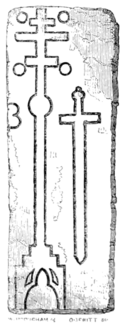Carlisle and Appleby. Soon after tins defeat Udard joined his kinsman Richard de Morville, and the other rebellions barons of the north, against the king, and he was in the year 1175 fined eighty marks. The record of this fine is as follows:
Pipe Roll, 22nd Hen. II.
Itẽ de Placitis Eorundem et in Westmarieland. Vdardus de Brohã ređđ comp̃ de qor. ta xx. m̃ ꝗ. fuit cũ inimicis Reg̃. In Thrõ xl. m̃. et debet xl. m̃.
Which may be thus rendered: "Also of pleas thereof in Westmorland. Udard de Broham renders account for eighty marks (four times twenty) because he was with the king's enemies. In the treasury forty marks, and he owes forty marks."
After the king had quelled the rebellion of the northern barons, and broken up their forces, Udard, according to the family tradition, took the cross in the second crusade under Conrad and Louis the Seventh of France. That he not only did so, but actually went to Palestine, seems now for the first time to be shewn by the discovery of his body as above described. The shirt of mail and sword, said to have belonged to him, are preserved among the armour at Brougham. The hauberk is of ring mail, of great size and unusual weight.
The discovery of Udard's body led to the examination of that portion of the chancel to the north of the place of his interment, which had not been used as a burying-place since the fifteenth century. This part, which measured about twelve feet by nine, had always been occupied as the family seat or pew, and was accordingly covered with a wooden floor. On raising this, the ground underneath appeared to be flagged. The first flag, five feet by about two, having been turned over was discovered to be an incised slab—a cross and sword being cut upon it, and on one side a large B, rudely cut. From the form of this cross, and of the arch in the base, the date may be assigned to the early part of the thirteenth century. The skeleton under this was of great size, the thigh bones measured upwards of twenty inches, and the length from the heel to the top of the skull six feet two inches. In this grave

